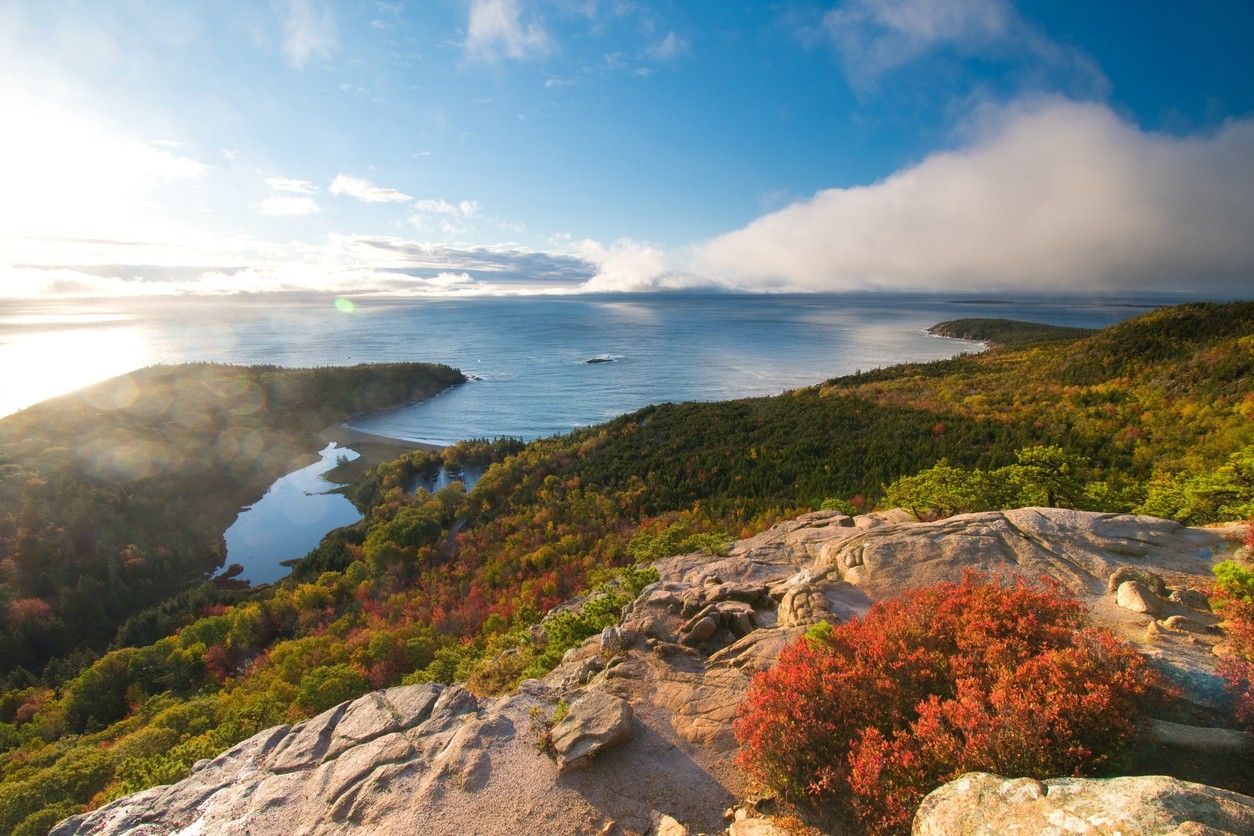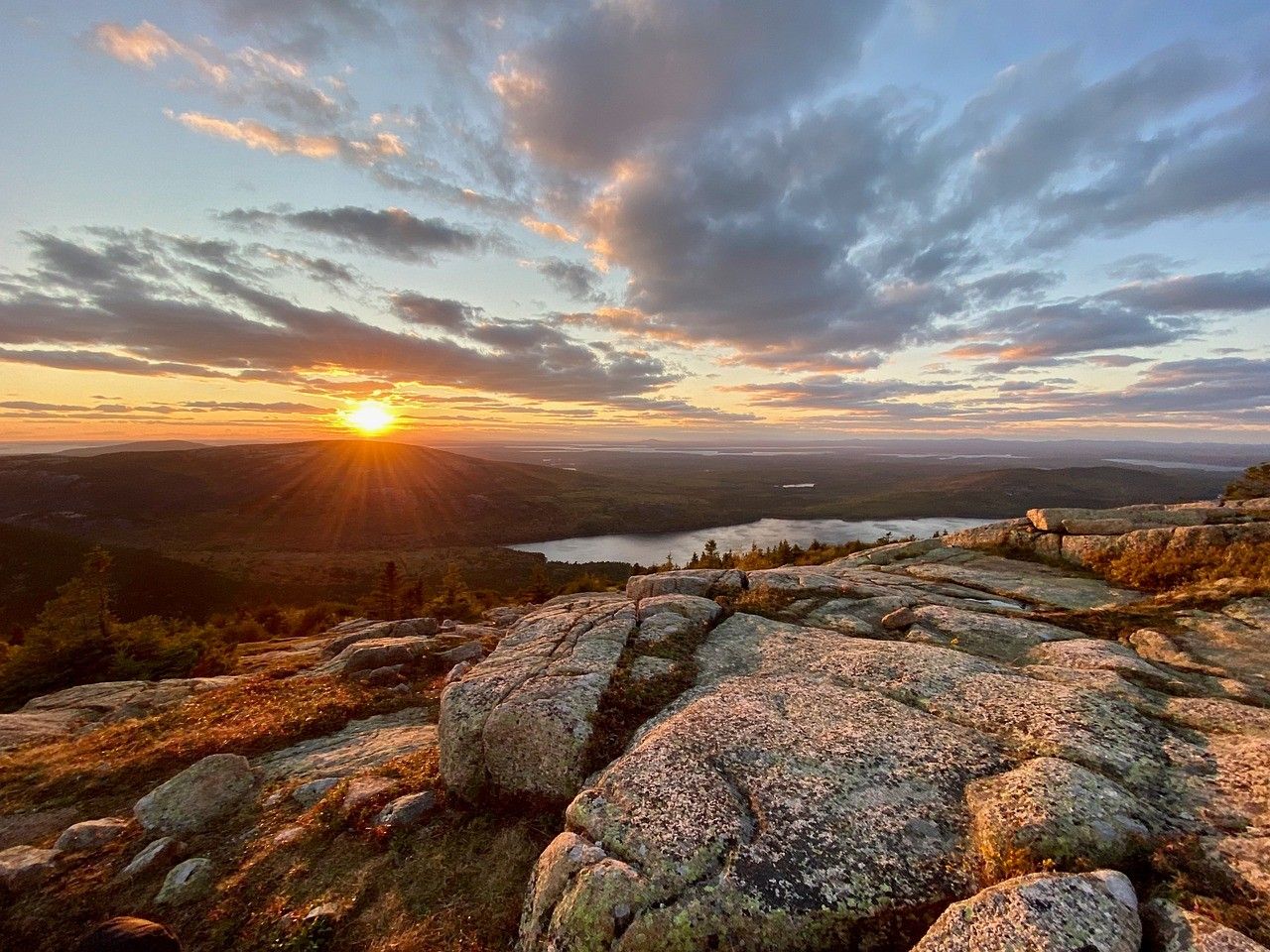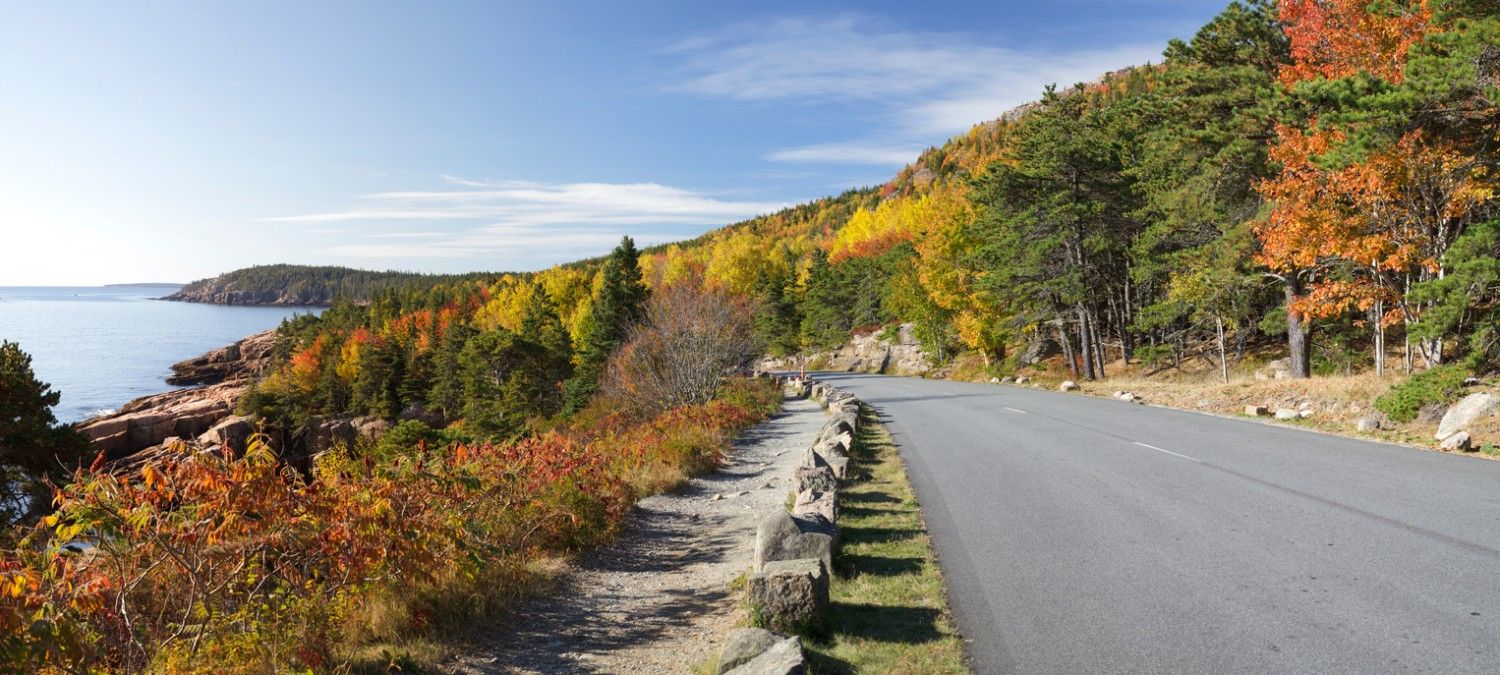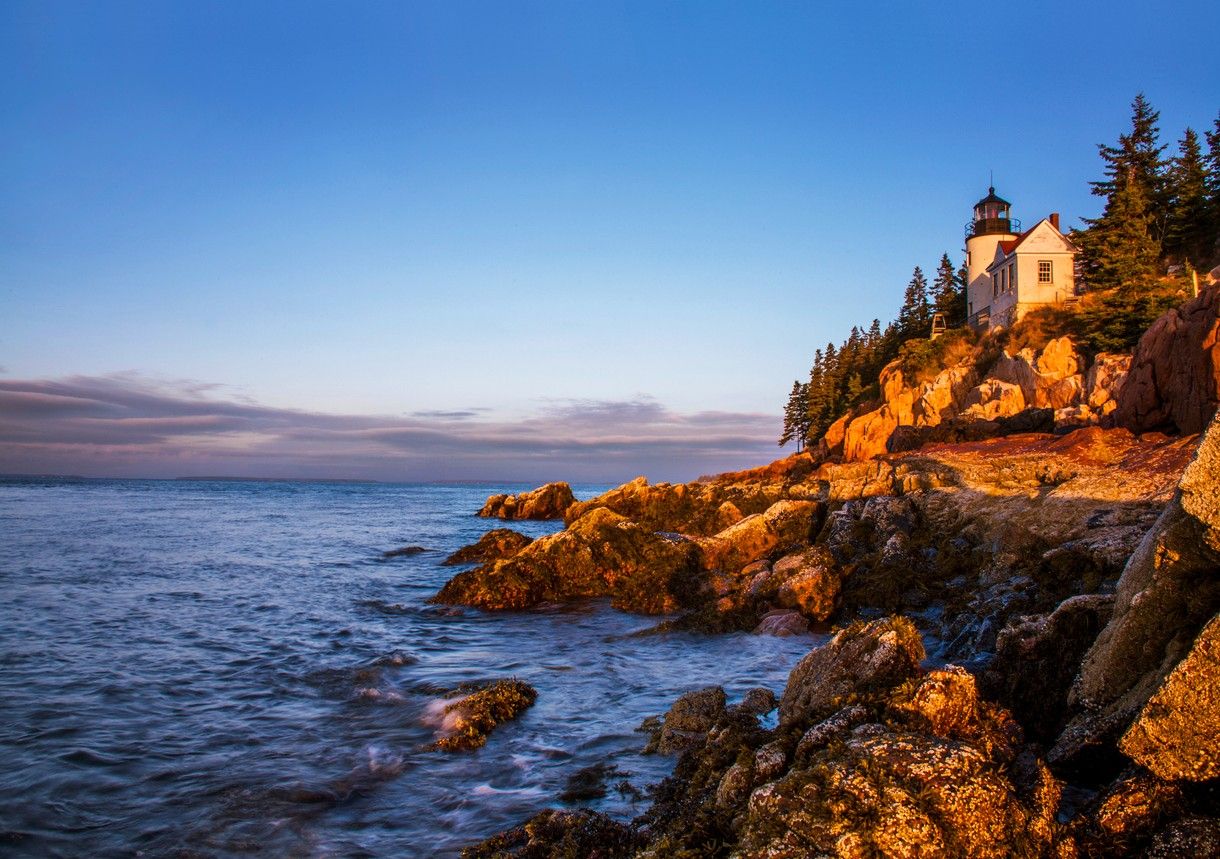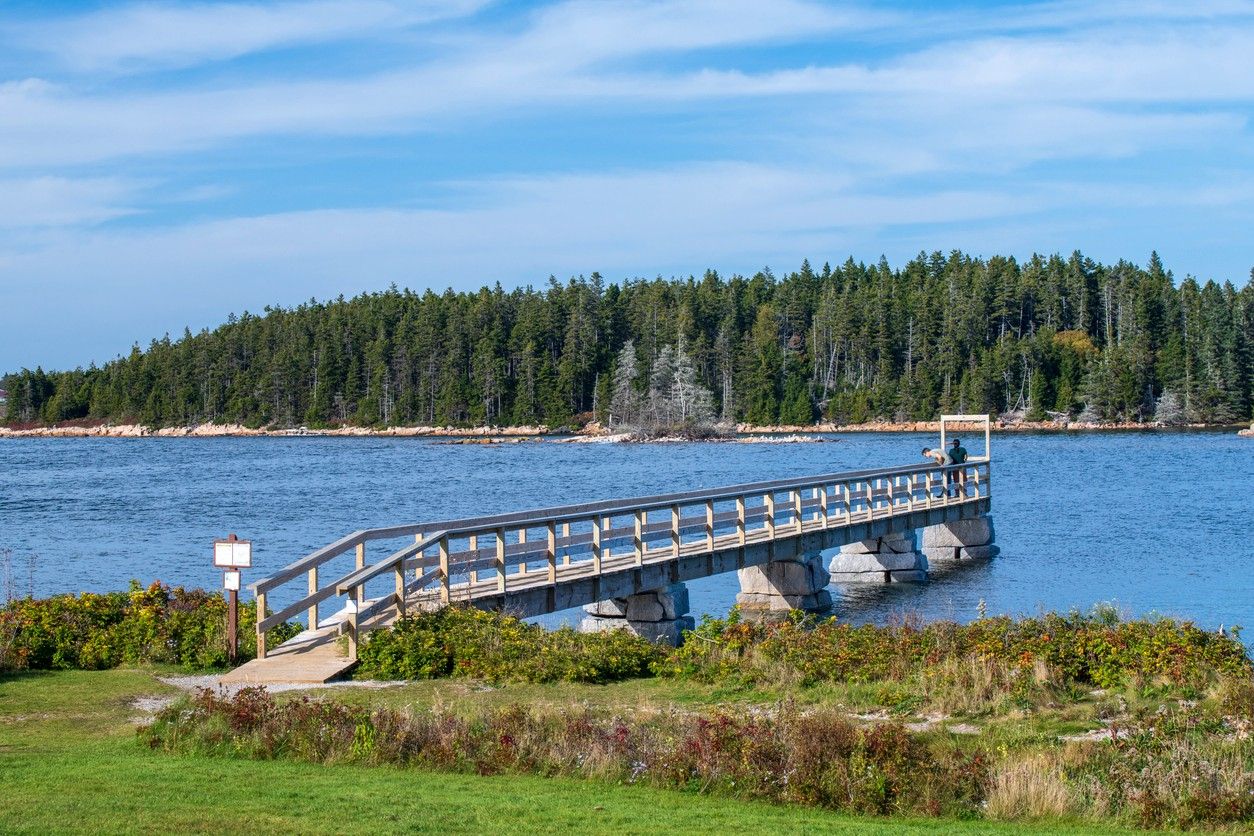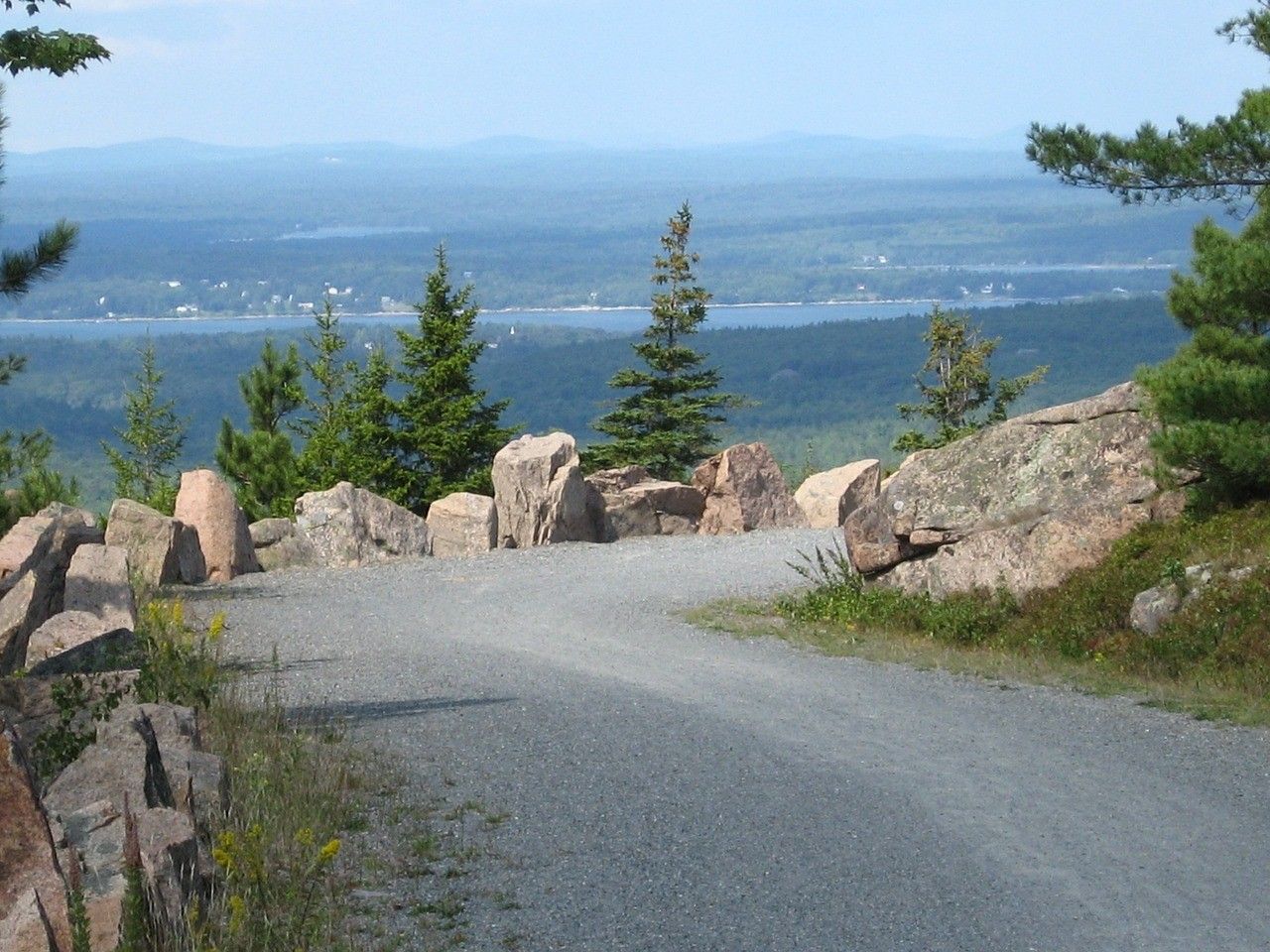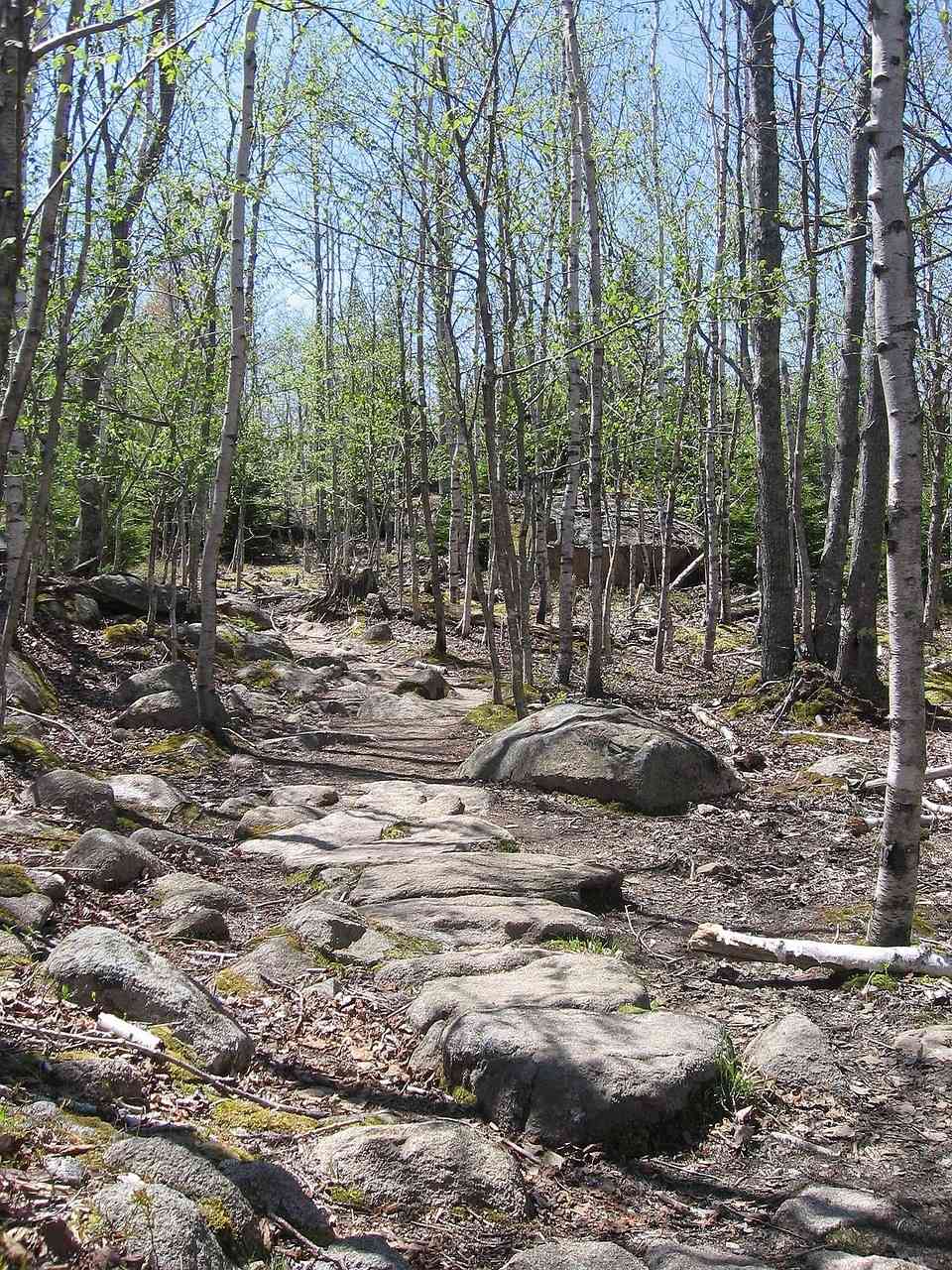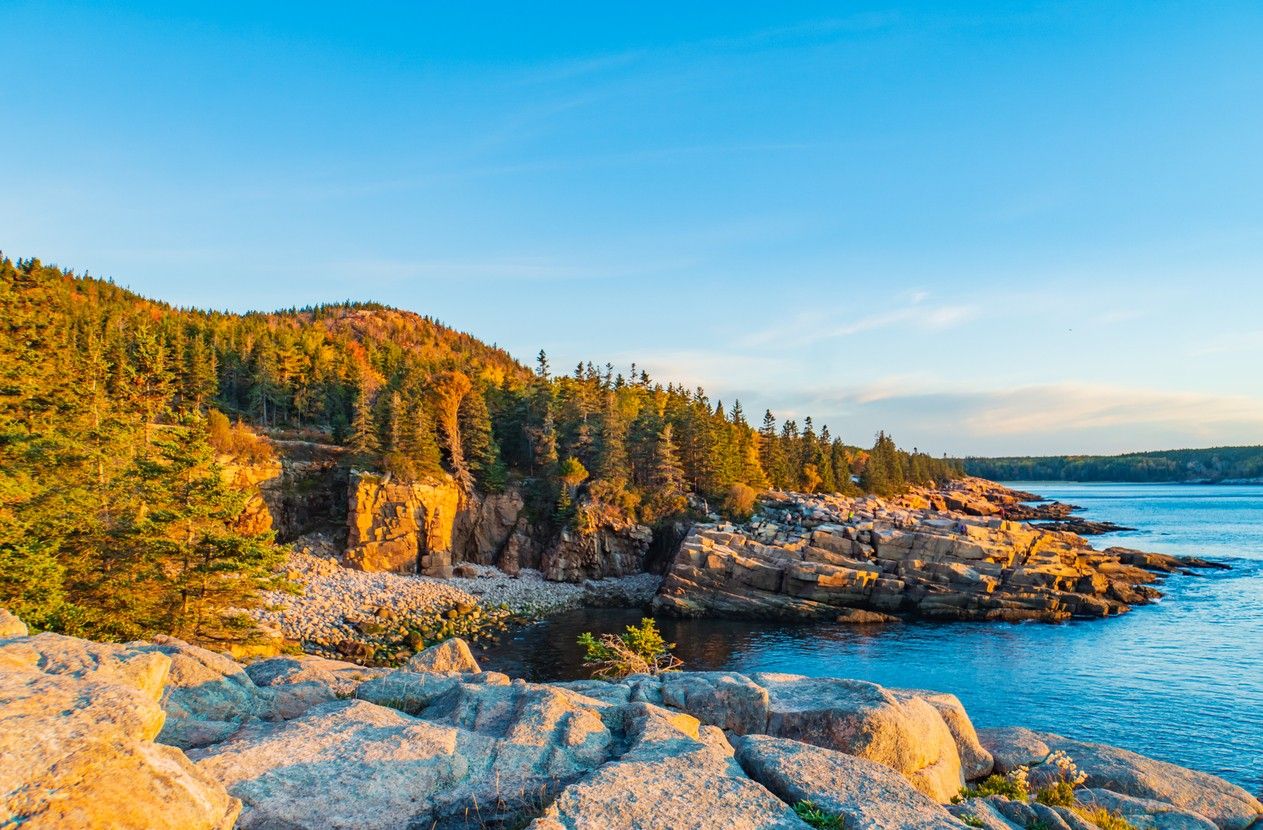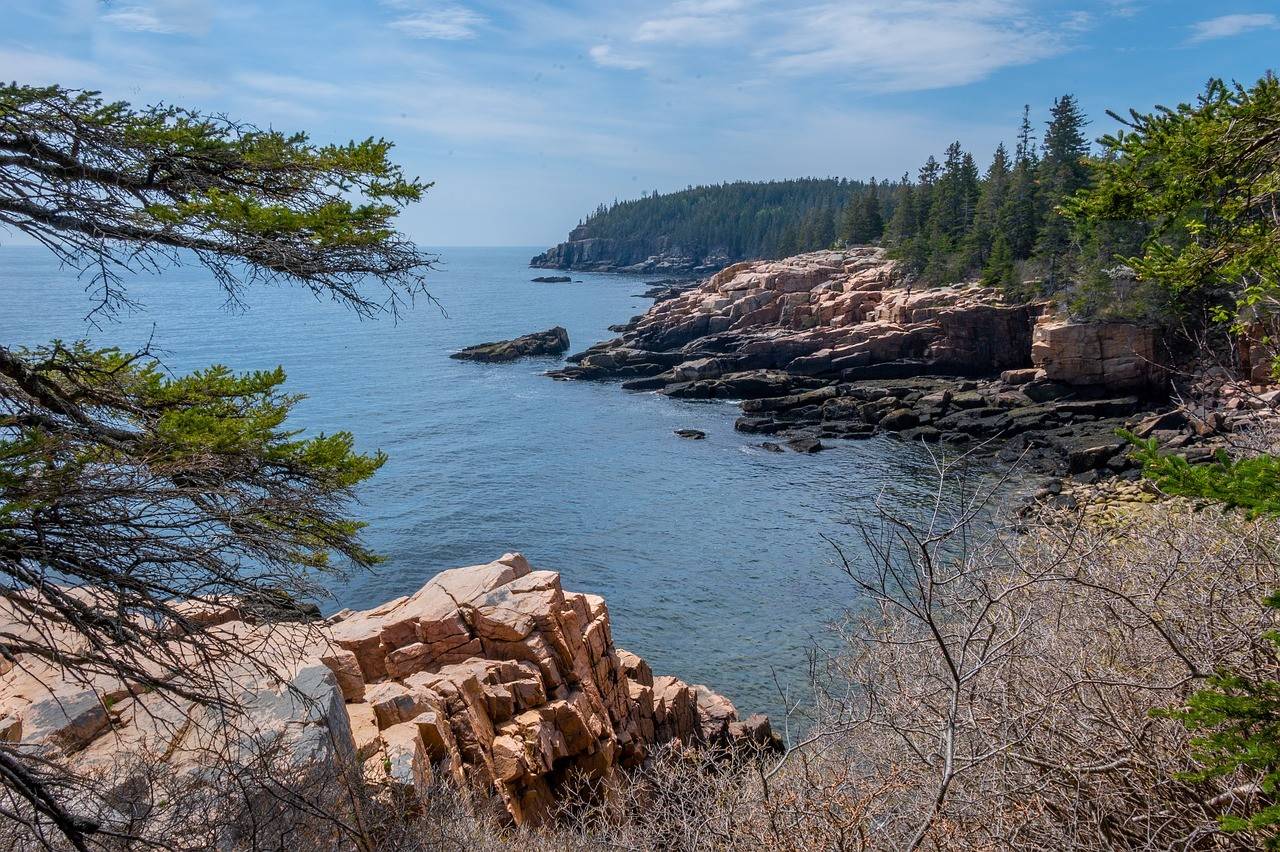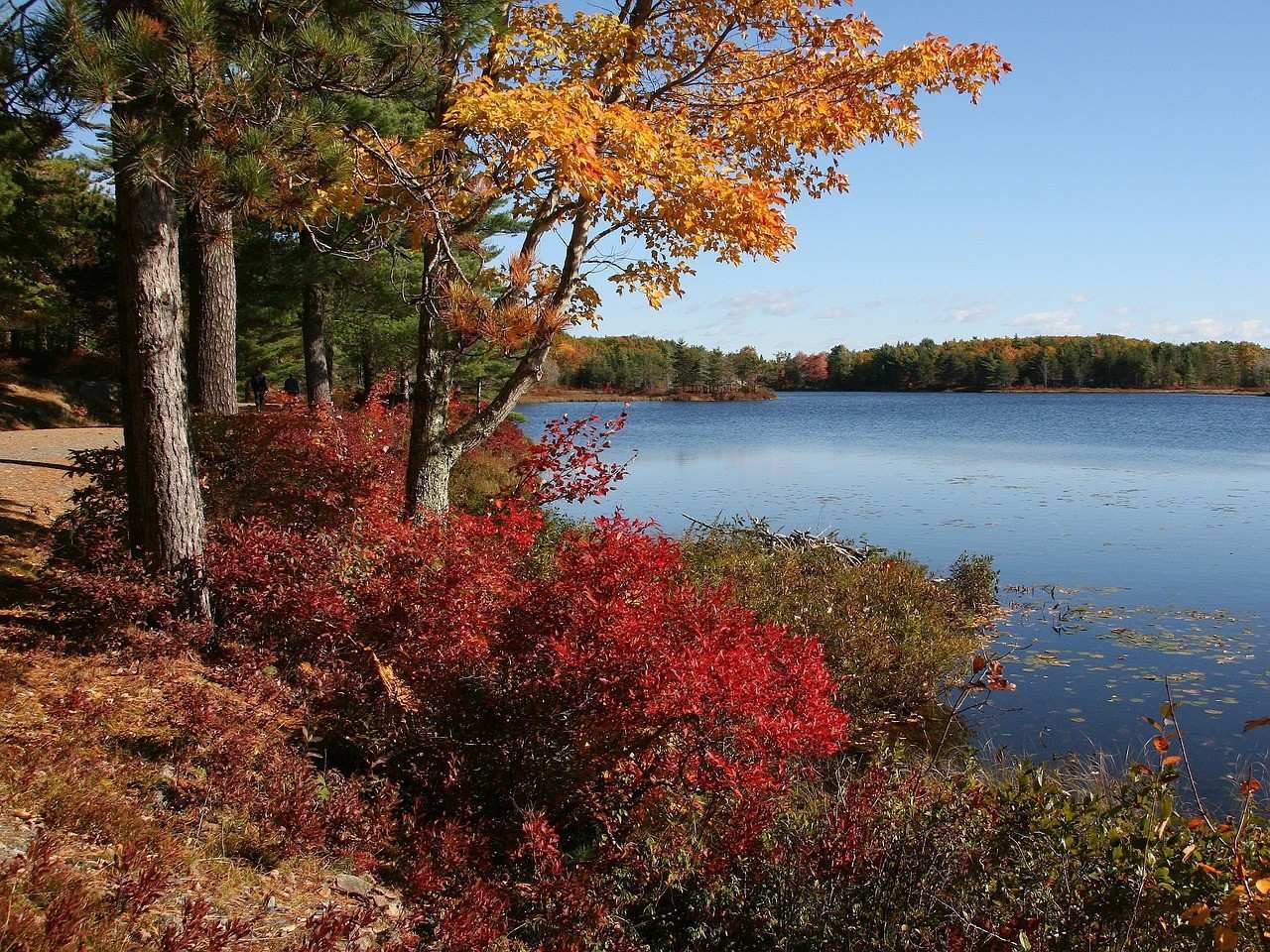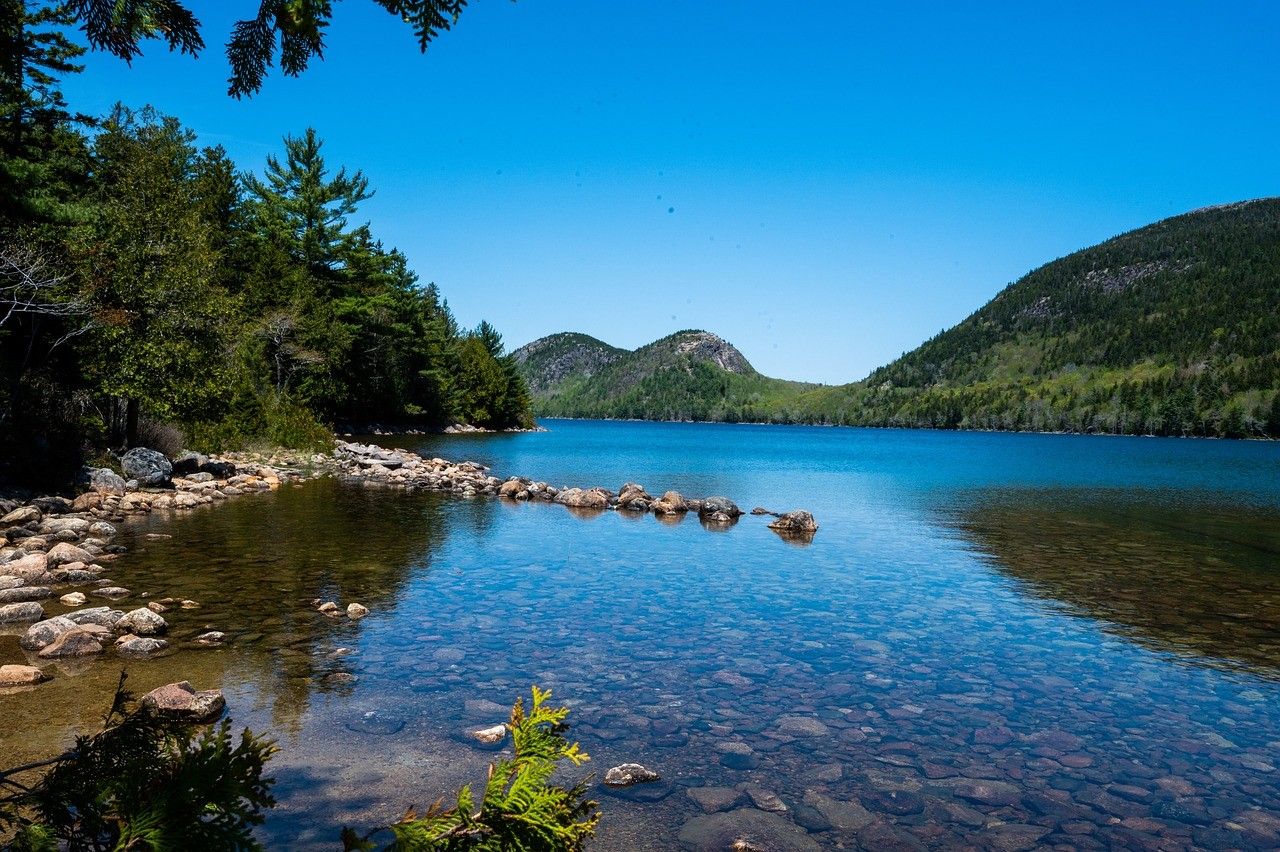Nestled along the rugged coast of Maine lies Acadia National Park, a breathtaking natural wonder that captivates visitors with its unparalleled beauty and diverse landscapes. As the first national park established east of the Mississippi River, Acadia has been enchanting nature enthusiasts since its inception in 1919. Spanning across Mount Desert Island, the Schoodic Peninsula, and several smaller islands, this 49,075-acre park offers a plethora of opportunities for exploration and adventure. Acadia's allure lies in its exceptional blend of mountains, forests, and seascapes.
The park's iconic granite peaks, such as Cadillac Mountain, provide sweeping vistas of the Atlantic Ocean and the surrounding islands. Cadillac Mountain is renowned for being the first place to witness the sunrise in the continental United States during certain times of the year. In addition to its mountaintop views, Acadia boasts over 120 miles of hiking trails that wind through lush forests, past serene lakes, and along dramatic coastal cliffs. The park's diverse ecosystems support an array of flora and fauna, making it a haven for wildlife enthusiasts. From the majestic moose and elusive black bears to the playful harbour seals and soaring bald eagles, Acadia is teeming with fascinating creatures. Meanwhile, the park's rugged shoreline is punctuated by pristine sandy beaches, secluded coves, and picturesque fishing villages that harken back to Maine's rich maritime heritage..
Must-See Attractions in Acadia National Park
Acadia National Park is brimming with natural wonders and breathtaking vistas that will leave you in awe. To make the most of your visit, be sure to explore these must-see attractions:
Cadillac Mountain
Towering at 1,530 feet, Cadillac Mountain is the highest point along the North Atlantic seaboard and the crown jewel of Acadia National Park. Located on Mount Desert Island, this iconic summit offers breathtaking panoramic views of the surrounding landscape, including the park's rugged coastline, pristine forests, and the distant islands of Frenchman Bay. One of the most popular ways to experience Cadillac Mountain is by driving the 3.5-mile Cadillac Summit Road, which winds its way to the top of the mountain. The road is open from mid-April through November, weather permitting, and features several scenic overlooks where visitors can stop to take in the stunning vistas. The drive to the summit takes approximately 20-30 minutes, depending on traffic and the number of stops made along the way.
Several hiking trails lead to the summit of Cadillac Mountain. The Cadillac North Ridge Trail, a moderate 4.4-mile round-trip hike, is one of the most popular routes. The trail begins at the Cadillac North Ridge Trailhead, located along the Park Loop Road, and climbs steadily through a series of switchbacks and rocky outcroppings before reaching the summit. Along the way, hikers are treated to increasingly spectacular views of the surrounding landscape, including the nearby Porcupine Islands and the distant peaks of the Schoodic Peninsula. Another popular hiking route is the Cadillac South Ridge Trail, a strenuous 7.4-mile round-trip hike that begins at the Blackwoods Campground. This trail is longer and more challenging than the North Ridge Trail, but rewards hikers with a more varied landscape, including dense forests, open ridges, and expansive views of the park's southern coastline.
On a clear day, visitors can see for miles in every direction, taking in the rugged beauty of the Atlantic coastline, the lush forests of Mount Desert Island, and the distant peaks of the mainland. Sunrise and sunset are particularly popular times to visit, as the summit offers a front-row seat to the breathtaking spectacle of the sun rising or setting over the ocean. In addition to its stunning views, Cadillac Mountain is also known for its unique geological features. The mountain is composed of granite that was formed over 400 million years ago, and its surface is covered with intricate patterns of cracks and fissures known as "granite joints." These joints were created by the repeated freezing and thawing of water over millions of years, and they give the mountain its distinctive weathered appearance.
Cadillac Mountain is also home to a variety of plant and animal life, including several rare and endangered species. The summit is covered with low-growing vegetation, including blueberries, cranberries, and various alpine plants that have adapted to the harsh conditions of the exposed granite. The mountain is also a popular spot for birdwatching, with several species of raptors and migratory birds using the summit as a stopover point during their annual migrations. Visitors to Cadillac Mountain should be prepared for changeable weather conditions, as the summit can be significantly cooler and windier than the surrounding lowlands. It's important to bring warm layers, even in the summer months, and to wear sturdy footwear with good traction for hiking on the mountain's rocky trails.
Jordan Pond
Jordan Pond is a stunning glacial lake located in the heart of Acadia National Park, offering visitors a tranquil and scenic escape from the bustling crowds of the park's more popular attractions. The pond, which is surrounded by the dramatic peaks of Penobscot and Pemetic Mountains, is one of the most picturesque and serene spots in the park, and a must-visit for anyone exploring the wonders of Mount Desert Island. Jordan Pond is located along the Park Loop Road, about halfway between the Hulls Cove Visitor Center and the Cadillac Mountain Summit Road. The pond is easily accessible by car, with a large parking area and several scenic overlooks and pull-offs located along the shore.
One of the most popular activities at Jordan Pond is hiking the Jordan Pond Shore Trail, a scenic 3.3-mile loop that circles the entire pond and offers stunning views of the surrounding mountains and forests. The trail is relatively flat and easy to navigate, making it a popular choice for families and casual hikers, and offers several opportunities for picnicking, birdwatching, and photography along the way. For those looking for a more challenging hike, the nearby Penobscot and Pemetic Mountain Trails offer stunning views of Jordan Pond and the surrounding landscape from high above. The Penobscot Mountain Trail, a strenuous 5.2-mile round trip hike, climbs steeply through dense forests and rocky outcroppings before reaching the summit of Penobscot Mountain, where hikers are rewarded with panoramic views of the pond and the distant peaks of Cadillac and Sargent Mountains.
Jordan Pond is also a popular spot for birdwatching, with over 330 species of birds having been recorded in the park, including several rare and endangered species. The pond is home to a variety of waterfowl, including loons, mergansers, and ring-necked ducks, as well as several species of warblers, thrushes, and sparrows that can be spotted in the surrounding forests. One of the most iconic features of Jordan Pond is the Jordan Pond House, a historic restaurant and gift shop located on the southern shore of the pond. The Jordan Pond House, which was built in the late 19th century and has been serving visitors to the park for over a century, is known for its famous popovers and tea, which have been a staple of the restaurant's menu for generations.
Visitors to the Jordan Pond House can enjoy a scenic lunch or afternoon tea on the restaurant's expansive lawn, which offers stunning views of the pond and the surrounding mountains. The gift shop, which is located adjacent to the restaurant, offers a variety of locally-made crafts, souvenirs, and artisanal foods, making it a popular spot for shopping and browsing. Jordan Pond is also a popular spot for kayaking and canoeing, with several local outfitters offering rentals and guided tours of the pond and the surrounding waterways. The pond's calm, clear waters and stunning scenery make it a perfect destination for a peaceful paddle and offer a unique perspective on the park's natural beauty. Visitors to Jordan Pond should be prepared for changeable weather conditions, as the park can experience fog, rain, and cool temperatures even in the summer months. It's important to bring warm layers and waterproof clothing, as well as sturdy footwear for exploring the park's many hiking trails and scenic overlooks.
Ocean Drive
Ocean Drive is a scenic section of the Park Loop Road that winds its way along the rugged coastline of Acadia National Park, offering visitors stunning views of the Atlantic Ocean, dramatic granite cliffs, and picturesque rocky beaches. The drive, which is located on the eastern side of Mount Desert Island, is one of the most popular and scenic routes in the park, and a must-do for anyone exploring the wonders of Acadia. Ocean Drive begins just beyond the entrance to Sand Beach, a stunning 290-yard stretch of sandy shoreline nestled between the towering granite cliffs of Mount Desert Island. From there, the road winds its way along the coast, offering increasingly dramatic views of the surrounding landscape, including the iconic Otter Cliff, a towering 110-foot granite cliff that rises straight out of the ocean.
One of the most popular stops along Ocean Drive is Thunder Hole, a dramatic natural feature where the crashing waves of the Atlantic Ocean have carved a narrow inlet into the granite cliffs. During high tide and rough seas, the waves can produce a thunderous boom as they crash into the narrow channel, sending water spraying high into the air and creating a spectacular display of nature's power. Just beyond Thunder Hole, visitors will encounter Monument Cove, a picturesque rocky beach that offers stunning views of the nearby islands and the distant peaks of the Schoodic Peninsula. The cove is a popular spot for photography and picnicking and offers a peaceful and scenic escape from the crowds of the more popular attractions along Park Loop Road.
Beyond Otter Point, Ocean Drive begins to turn inland, passing by several more scenic overlooks and trailheads before eventually rejoining the Park Loop Road near the Fabbri Memorial, a historic stone memorial dedicated to the memory of a local conservationist and philanthropist. Along the way, visitors to Ocean Drive should keep an eye out for the park's diverse wildlife, including harbour seals, which can often be spotted sunning themselves on the rocky outcroppings along the shore, and a variety of seabirds, including gulls, cormorants, and eider ducks.
One of the best ways to experience the stunning beauty of Ocean Drive is by taking a scenic drive along the Park Loop Road, stopping at the various overlooks and pull-offs along the way to take in the breathtaking views and snap a few photos. However, for those looking for a more immersive experience, several hiking trails offer stunning views of the coastline and the surrounding landscape. The Ocean Path, a 2-mile hiking trail that runs parallel to Ocean Drive, offers a more intimate and up-close experience of the park's rugged coastline, with several opportunities for exploring the rocky beaches and tide pools along the way. The trail is relatively flat and easy to navigate, making it a popular choice for families and casual hikers, and offers stunning views of the Atlantic Ocean and the nearby islands.
Bass Harbor Head Lighthouse
Bass Harbor Head Lighthouse is a historic and picturesque lighthouse located on the southern tip of Mount Desert Island in Acadia National Park. The lighthouse, which was built in 1858 and has been guiding ships through the treacherous waters of the Maine coast for over 160 years, is one of the most iconic and photographed landmarks in the park, and a must-visit for anyone exploring the wonders of Acadia. The lighthouse is located on a rugged, rocky promontory that juts out into the Atlantic Ocean, offering stunning views of the surrounding coastline and the nearby islands. The lighthouse itself is a 32-foot tall brick tower that is painted white, with a distinctive red lantern room at the top. The tower is attached to a small, white keeper's house, which served as the residence for the lighthouse keeper and their family for many years. Today, the lighthouse is no longer actively used for navigation but is instead maintained by the United States Coast Guard as a historic landmark and tourist attraction. Visitors to the lighthouse can explore the grounds and take in the stunning views of the surrounding landscape, including the rugged cliffs, crashing waves, and distant islands.
One of the best ways to experience the beauty of Bass Harbor Head Lighthouse is by taking a short hike along the nearby trails. The lighthouse is located just off Route 102A, and there is a small parking area near the entrance to the lighthouse grounds. From there, visitors can follow a short, easy trail that leads to the base of the lighthouse and offers stunning views of the surrounding coastline. There is also a longer hiking trail that leads from the parking area down to the rocky shore below the lighthouse. The trail is relatively steep and can be slippery in wet conditions, but offers a unique and up-close perspective on the rugged beauty of the Maine coast, with stunning views of the crashing waves and the nearby islands. Visitors to Bass Harbor Head should also take the time to explore the surrounding area, which is home to some of the most picturesque and unspoiled landscapes in Acadia National Park. Just a short drive from the lighthouse, visitors can explore the nearby Ship Harbor Trail, a 1.3-mile loop trail that offers stunning views of the rugged coastline and the nearby islands, as well as the chance to see a variety of seabirds and other wildlife.
Another popular nearby attraction is the Wonderland Trail, a short, easy hike that leads to a stunning coastal landscape of pink granite cliffs, tidepools, and crashing waves. The trail is just a 10-minute drive from the lighthouse and offers a perfect opportunity to explore the rugged beauty of the Maine coast up close. Visitors to Bass Harbor Head Lighthouse should also take the time to explore the charming nearby town of Bass Harbor, which is home to a variety of local shops, restaurants, and galleries. The town is known for its strong fishing heritage and its picturesque working waterfront, where visitors can watch local lobstermen unloading their catch and repairing their boats.
Schoodic Peninsula
The Schoodic Peninsula is a breathtakingly beautiful and unspoiled section of Acadia National Park that is often overlooked by visitors in favour of the more popular attractions on Mount Desert Island. However, those who take the time to explore this stunning coastal landscape will be rewarded with a truly unforgettable experience, complete with rugged cliffs, crashing waves, and pristine forests that are home to an incredible diversity of wildlife. The Schoodic Peninsula is located just a short drive from the town of Winter Harbor, on the eastern side of Frenchman Bay. The peninsula is home to a variety of stunning natural features, including the dramatic Schoodic Point, a rugged granite headland that juts out into the Atlantic Ocean and offers stunning views of the surrounding islands and coastline.
One of the best ways to experience the beauty of the Schoodic Peninsula is by taking a scenic drive along the 8-mile Schoodic Loop Road, which winds its way along the coast and offers stunning views of the surrounding landscape at every turn. Along the way, visitors can stop at various overlooks and pull-offs to take in the breathtaking views and snap a few photos, or even take a short hike along one of the nearby trails. One of the most popular hikes on the Schoodic Peninsula is the Anvil Trail, a moderate 2.4-mile round-trip hike that leads to the summit of Schoodic Head, the highest point on the peninsula. From the summit, hikers are treated to stunning panoramic views of the surrounding coastline, including the nearby islands and the distant peaks of Mount Desert Island.
Another popular destination on the Schoodic Peninsula is the Schoodic Institute, a non-profit organisation that is dedicated to promoting scientific research and education in the park. The institute offers a variety of educational programs and workshops throughout the year, as well as guided tours and hikes that offer a unique and in-depth look at the natural and cultural history of the area. In addition to its stunning natural beauty, the Schoodic Peninsula is also home to an incredible diversity of wildlife, including a variety of seabirds, such as puffins and razorbills, as well as harbour seals, porpoises, and even the occasional whale. Visitors to the peninsula should keep an eye out for these fascinating creatures, as well as the many other species of plants and animals that call this unique and unspoiled landscape home.
Visitors to the Schoodic Peninsula should be prepared for changeable weather conditions, as the park can experience fog, rain, and cool temperatures even in the summer months. It's important to bring warm layers and waterproof clothing, as well as sturdy footwear for exploring the nearby hiking trails and rocky shorelines. Another great way to experience the beauty of the Schoodic Peninsula is by taking a boat tour of the surrounding waters. Several local companies offer guided tours of the area, including scenic cruises that offer stunning views of the coastline and the nearby islands, as well as wildlife-watching tours that offer the chance to see seabirds, seals, and other marine life up close.
Hiking and Biking Trails in Acadia National Park
Acadia National Park is a hiker's paradise, offering over 120 miles of well-maintained trails that cater to all skill levels. Here are some of the best hiking and biking trails in Acadia:
Hiking Trails
Beehive Trail — This challenging 1.4-mile trail is not for the faint of heart, as it involves steep climbs and iron rungs. However, the breathtaking views of Sand Beach and the Atlantic Ocean from the summit are well worth the effort. Be sure to wear sturdy shoes and take your time navigating the steep and narrow sections of the trail.
Ocean Path — This easy 2-mile trail follows the rugged coastline from Sand Beach to Otter Point, offering stunning views of the Atlantic Ocean and the park's iconic granite cliffs. Along the way, you'll pass by Thunder Hole and Monument Cove, two of Acadia's most popular attractions. This trail is perfect for families and those seeking a stroll with breathtaking scenery.
Jordan Pond Shore Trail — This moderate 3.3-mile loop trail encircles the serene Jordan Pond, offering stunning views of the water and the surrounding Bubbles Mountains. The trail is relatively flat and easy to navigate, making it a great option for hikers of all skill levels. Be sure to stop by the Jordan Pond House for a refreshing cup of tea and a popover after your hike.
Precipice Trail — Not for the faint of heart, this challenging 1.5-mile trail involves steep climbs, narrow ledges, and iron rungs. However, the panoramic views from the top of Champlain Mountain are truly breathtaking. Due to its difficulty and exposure, this trail is only recommended for experienced hikers with a good level of fitness and no fear of heights.
Gorham Mountain Trail — This moderate 1.8-mile trail offers a less crowded alternative to the more popular Cadillac Mountain hike. The trail winds through lush forests and over granite ledges, offering stunning views of the Atlantic Ocean and the surrounding islands. The summit of Gorham Mountain provides a panoramic vista of Acadia's rugged coastline and is a great spot for a picnic.
Biking Trails
Carriage Roads — Acadia's historic carriage roads, a gift from John D. Rockefeller Jr., offer 45 miles of well-maintained, car-free paths that wind through the park's stunning landscapes. These gravel roads are perfect for biking, with gentle grades and stunning views of the mountains, lakes, and forests. Don't miss the iconic stone bridges, such as the Cobblestone Bridge and the Duck Brook Bridge, which add to the charm of these historic roads.
Schoodic Peninsula Loop — This 8.3-mile loop on the Schoodic Peninsula offers a quieter and less crowded biking experience compared to the carriage roads on Mount Desert Island. The route follows the one-way Schoodic Loop Road, offering stunning views of the rugged coastline, granite cliffs, and offshore islands. Be sure to stop at Schoodic Point for a breathtaking view of the Atlantic Ocean crashing against the rocky shore.
Witch Hole Pond Loop — This easy 3.3-mile loop is perfect for families and casual bikers looking for a scenic ride through Acadia's lush forests. The trail follows the carriage roads around Witch Hole Pond, offering a peaceful and picturesque setting.
Outdoor Activities in Acadia National Park
Kayaking and Canoeing — With its rugged coastline, hidden coves, and pristine lakes, Acadia is a paradise for paddling enthusiasts. Rent a kayak or canoe and explore the park's stunning waterways, such as the serene Eagle Lake or the dramatic Sea Caves of Mount Desert Island. Guided tours are available for those who want to learn more about the park's unique geology and wildlife while paddling.
Rock Climbing — Acadia's granite cliffs and sea stacks offer world-class rock climbing opportunities for experienced climbers. Popular climbing areas include Otter Cliff, Great Head, and South Bubble. Be sure to check with the park's visitor centre for information on climbing regulations and safety guidelines.
Birdwatching — Acadia is home to over 330 species of birds, making it a paradise for birdwatching enthusiasts. From the majestic bald eagles and peregrine falcons to the colourful warblers and seabirds, there's always something to spot in the park's diverse habitats. Don't miss the annual Hawkwatch at the top of Cadillac Mountain, where you can observe the impressive migration of hawks, falcons, and ospreys.
Fishing — Acadia's lakes, ponds, and streams offer excellent fishing opportunities for anglers of all skill levels. Cast a line in the crystal-clear waters of Jordan Pond or Eagle Lake and try your luck at catching brook trout, landlocked salmon, or smallmouth bass. Be sure to obtain a valid fishing license and follow the park's fishing regulations.
Stargazing — With its dark skies and minimal light pollution, Acadia is a stargazer's dream. Attend a ranger-led stargazing program or find a secluded spot in the park to marvel at the breathtaking display of stars, planets, and galaxies. The summit of Cadillac Mountain is a particularly popular spot for stargazing, offering a panoramic view of the night sky.
Scenic Boat Tours — Explore Acadia's rugged coastline and offshore islands from a different perspective by taking a scenic boat tour. Choose from a variety of options, such as a nature cruise, a lobster boat tour, or a whale-watching excursion. Learn about the park's unique geology, wildlife, and maritime history while enjoying stunning views of the Atlantic Ocean and the surrounding islands.
Horseback Riding — Experience Acadia's stunning landscapes on horseback by taking a guided trail ride through the park's lush forests and along its scenic carriage roads. Rides are available for all skill levels, from beginner to advanced, and offer a unique and memorable way to explore the park's beauty.
Winter Activities — Acadia's natural beauty doesn't disappear in the winter months; it simply takes on a new form. Enjoy cross-country skiing or snowshoeing on the park's carriage roads and hiking trails, or try your hand at ice fishing on one of the park's frozen lakes. The park also offers ranger-led snowshoe hikes and winter ecology walks, allowing you to learn about the park's unique winter landscape and wildlife.
Visitor Tips and Practical Information
To ensure a safe, enjoyable, and memorable visit to Acadia National Park, consider the following visitor tips and practical information:
Best Time to Visit — The peak season for visiting Acadia is from June to August when the weather is warm and sunny, and all park facilities and services are open. However, this is also the busiest time of year, with large crowds and limited parking. For a quieter experience and stunning fall foliage, consider visiting in September or October. Winter visits offer a unique and peaceful experience, with opportunities for cross-country skiing, snowshoeing, and ice fishing.
Park Entrance Fees — Acadia National Park charges an entrance fee, which varies depending on the season and the type of vehicle. As of 2021, the fees are $30 per vehicle, $25 per motorcycle, and $15 per individual (on foot or bicycle) for a 7-day pass. Consider purchasing an annual pass for $55 if you plan on visiting the park multiple times a year.
Parking and Transportation — During peak season, parking can be challenging in popular areas like Cadillac Mountain and Jordan Pond. To avoid congestion, consider using the Island Explorer, a free shuttle bus system that operates throughout the park and the surrounding towns. The shuttle runs from late June through early October and serves most major trailheads, carriage road entrances, and popular destinations.
Weather and Clothing — Acadia's weather can be unpredictable, with temperatures ranging from cool and foggy to warm and sunny, even in the summer months. Be sure to pack layers, including a light jacket or sweater, and comfortable, sturdy shoes for hiking. Don't forget to bring sunscreen, a hat, and insect repellent, as well as plenty of water and snacks for your outdoor adventures.
Safety and Leave No Trace — When exploring Acadia's trails and natural areas, always prioritise safety and practice Leave No Trace principles. Stay on marked trails, respect wildlife and park regulations, and pack out all trash and waste. Be prepared for sudden weather changes and bring appropriate gear for your chosen activities. If you're planning on hiking alone, be sure to let someone know your itinerary and expected return time.
Ranger-Led Programs — Acadia offers a wide range of ranger-led programs throughout the year, including guided hikes, boat tours, and educational talks. These programs are a great way to learn about the park's unique ecology, history, and culture, and to gain a deeper appreciation for its natural wonders. Check the park's website or visitor centre for a schedule of upcoming programs.
Pet-Friendly Visits — Acadia is a pet-friendly park, with many trails and carriage roads open to leashed pets. However, there are some restrictions, such as no pets allowed on ladder trails, in public buildings, or on the Island Explorer shuttle buses. Be sure to clean up after your pet and respect other visitors' experiences.
Camping and Lodging — Acadia offers several campgrounds within the park, including Blackwoods, Seawall, and Schoodic Woods. Reservations are highly recommended, especially during peak season. If you prefer indoor accommodations, the nearby towns of Bar Harbor, Southwest Harbor, and Winter Harbor offer a wide range of options, from luxury resorts to cosy bed and breakfasts.
Dining and Shopping — The towns surrounding Acadia offer a variety of dining options, from casual seafood shacks to fine dining restaurants. Be sure to try some of Maine's famous lobster, clams, and blueberries. For shopping, you'll find a mix of souvenir shops, art galleries, and outdoor gear stores in Bar Harbor and the other nearby towns.
Accessibility — Acadia National Park is committed to providing accessible facilities and services for visitors with disabilities. Many of the park's trails, carriage roads, and visitor centres are wheelchair accessible, and the Island Explorer shuttle buses are equipped with lifts. The park also offers an Access Pass, which provides free lifetime admission for U.S. citizens or permanent residents with permanent disabilities.
Related articles

Let us know you agree to cookies
We use marketing, analytical and functional cookies as well as similar technologies to give you the best experience. Third parties, including social media platforms, often place tracking cookies on our site to show you personalised adverts outside of our website.
We store your cookie preferences for two years and you can edit your preferences via ‘manage cookies’ or through the cookie policy at the bottom of every page. For more information, please see our cookie policy.
